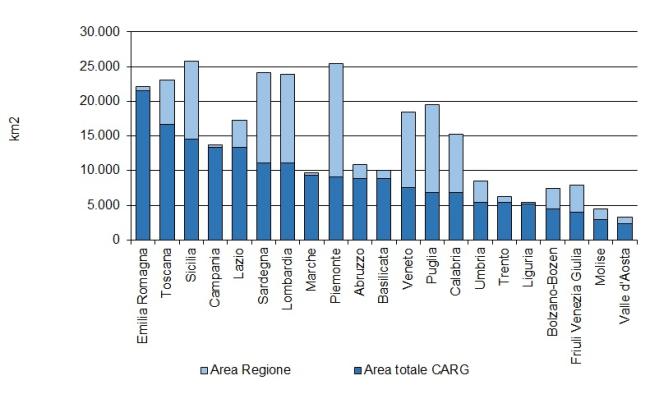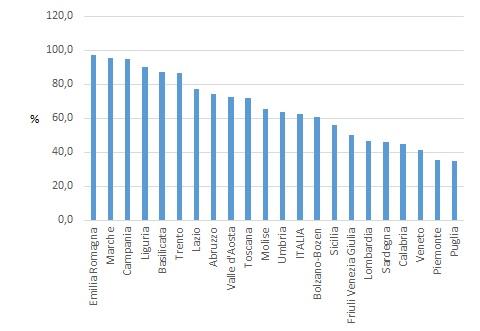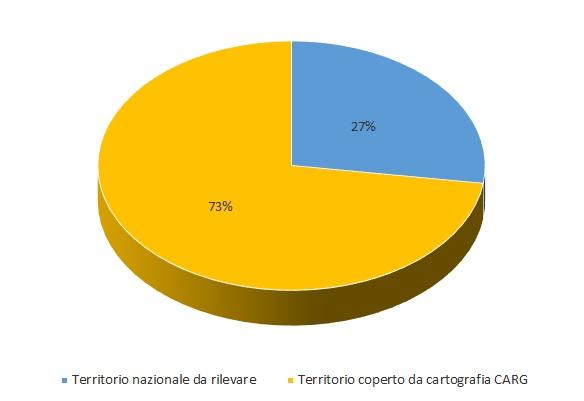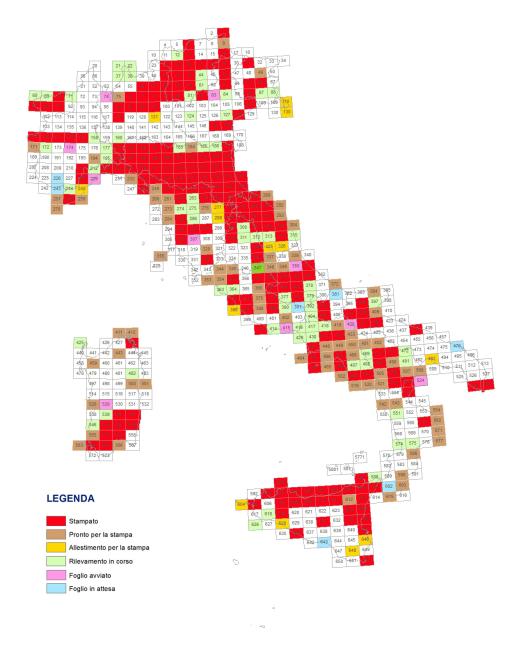Panel 1
Roberta Carta, Fiorenzo Fumanti, Teresa Lettieri
The Geological Mapping Project of Italy at a scale of 1:50,000 (CARG Project) aims to achieve complete coverage of the Italian territory through the creation of 636 sheets that make up the Geological Map of Italy at a scale of 1:50,000. As of now, the geological sheets currently in progress and those already completed cover approximately 62% of the national territory.
The indicator is based on the Geological Mapping Project (CARG Project) of ISPRA, which provides for the complete coverage of the Italian territory through the creation of 636 sheets that constitute the Geological Map of Italy at a scale of 1:50,000. The data collected by the CARG Project is digitized at a scale of 1:25,000 and forms the national geological database.
The CARG Project is carried out in collaboration with the regions and autonomous provinces, the CNR, and universities, and is coordinated by the Department for the Geological Survey of Italy (SGd’I) - ISPRA, as the state’s official cartographic body (L 68/60). The regions and autonomous provinces may contribute additional financial resources for the production of geological sheets. The surveys are conducted following nationally valid guidelines specifically prepared for this purpose.
For completeness, geological sheets at a scale of 1:50,000 produced prior to the CARG Project have also been considered. The indicator provides data on the progress of updated official geological mapping at a scale of 1:25,000, which is the reference scale for field surveys.
To enhance geological knowledge of the Italian territory through mapping, a fundamental tool for all activities related to planning, risk prediction/prevention, and natural resource management.
There is no reference legislation against which to assess the progress of the project. The activities, funding, and methods of fund allocation for the CARG Project were defined by L. 67/88 with the related CIPE Resolution of 05/08/88, L. 305/89 with the related CIPE Resolution of 03/08/90, which frames the project within the "Three-Year Environmental Protection Program," and L. 438/95, 226/99, and 365/00.
The 2019 Budget Law (L.160/19) allocated ISPRA €15 million for the 2020-2022 period; the 2020 Budget Law allocated an additional €10 million for 2021-2022, and the 2021 Budget Law (L.178/2020 - paragraph 742) allocated a further €6 million for 2022.
Panel 2
ISPRA - Quaderni Serie III del Servizio Geologico d’Italia - Linee guida per la realizzazione della Carta Geologica e Geotematica alla scala 1:50.000 – ISPRA – Quaderni dal n. 1/1992 al n. 15/2022.
Dependence on project progress and the availability of dedicated resources.
Data quality assessment
ISPRA (Italian Institute for Environmental Protection and Research),
Autonomous Provinces,
Regions,
Universities
http://www.isprambiente.gov.it/Media/carg/
National
1988- november 2024
Indicator assessment
Quantification of official geological maps produced by executing entities (territorial bodies, CNR institutions, university departments and institutes, regions, and autonomous provinces) based on the guidelines developed by the Geological Survey of Italy of ISPRA. Geological survey data, collected at scales of 1:10,000 and 1:25,000, are digitized at a scale of 1:25,000 and form the national geological database.
The geological sheets currently in progress and those already completed now cover approximately 62% of the national territory (Figure 3), elaborated according to CARG criteria, which serve as the reference basis for the production of official sheets at a scale of 1:50,000.
Delays occurred during the implementation of the Project, which were offset by an acceleration in recent years, leading to an increase in the coverage of the national territory compared to that achieved in the survey sheets funded prior to the 2020–2022 Budget Laws. With the new funding provided by these regulations, survey activities have resumed, allowing for a reversal of the negative trend that had persisted since 2004.




Figures 1 and 2 show that Marche, Campania, and Emilia-Romagna are now close to full coverage of their territory with geological maps at an appropriate scale, also intended for planning activities. The progress in other regions is slower, with less than half of them having official geological mapping coverage below 50%.
Figures 1 and 2, while considering the actually surveyed areas for which at least the original author manuscripts are available, also include sheets currently in progress, regardless of whether their corresponding sheets at a scale of 1:50,000 are completed. As shown in Figure 3, just under half of the national territory still needs to be surveyed.
Before L. 160/19, which led to the project’s revival, the CARG Project had produced or was completing 254 geological sheets, supplemented by 5 sheets fully funded by some regions such as Puglia, Lazio, and Liguria, and 22 geological sheets created by the Geological Survey of Italy outside of the CARG Project, for a total of 281 geological sheets at a scale of 1:50,000.
With the funding provided by the last three Budget Laws (2020, 2021, 2022), 96 new sheets have been initiated, one of which has already been completed. Additionally, one geological sheet fully funded by the Lazio Region is in the initiation phase, bringing the total to 378 sheets out of 635.
Of these, 282 sheets have been completed, 204 have been printed, 77 are in the printing phase, and 14 are being prepared for printing (Figure 4). The area covered by CARG mapping represents approximately 62% of the national cartographic coverage.